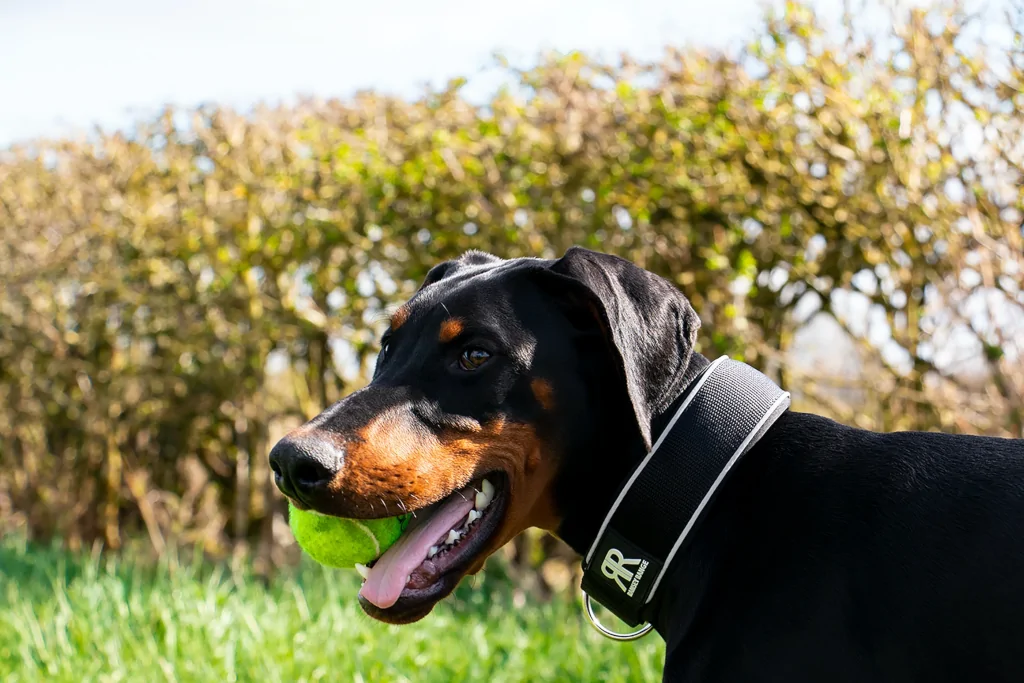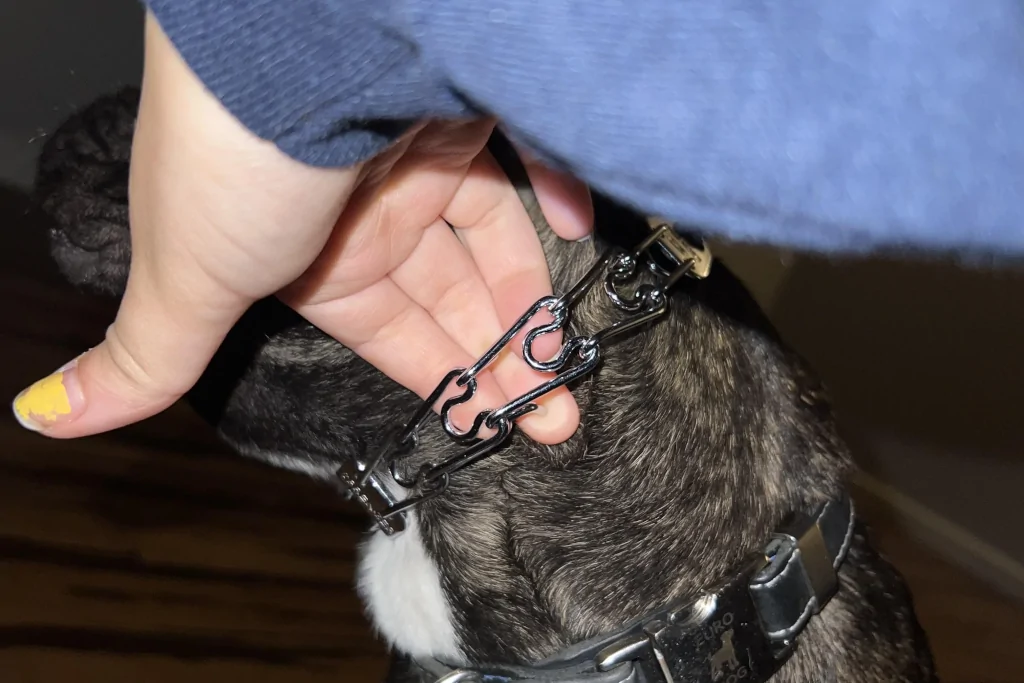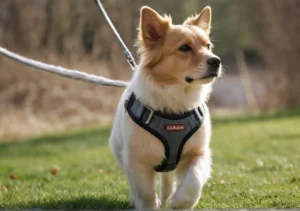Disclosure: We may earn a commission from helpful, relevant links in our content. No cost to you. See our privacy policy.
Picture this: I’m standing in the park, armed with treats and a leash, trying to train my rambunctious dog who just can’t seem to stay focused. It’s a familiar scene for many dog owners, right?
Then, out of nowhere, my dog spots a squirrel and takes off like a rocket, dragging me through the grass and leaving me with scraped knees and a bruised ego.
But what if I told you there’s a training tool that could have prevented that embarrassing and painful moment, and saved me, and you, from countless hours of frustration?
Enter the world of dog training collars, a game changer for obedience training and behavior management. But don’t just take my word for it – let’s dive into the benefits and considerations of these collars, and help you find the perfect fit for your furry friend.
For reference, here are our other guides:
Choosing the Right Dog Training Leash
Choosing the Right Dog Training Harness
Top Clickers for Dog Training

Why Use a Training Collar for Your Dog?
Training collars are designed to help you communicate more effectively with your dog during training sessions.
They provide a clear and consistent signal that helps your dog understand what behavior is desired, making the training process smoother and more enjoyable for both of you.
Additionally, training collars can help address common issues like excessive barking, jumping, or pulling on the leash. By incorporating a training collar into your routine, you’ll be able to tackle these challenges and strengthen the bond between you and your canine companion.
What Are the Different Types of Training Collars Available?

Flat Collars
The most common type of collar is the flat collar. While not specifically designed for training, they are suitable for most dogs and are often used for basic obedience training and everyday wear.
Flat collars are made from various materials, such as nylon or leather, and can be easily adjusted to fit your dog’s neck size. The Blueberry Pet Classic Solid Color Dog Collar is a popular choice for its durability and variety of colors.

Tip:
Martingale Collars
Martingale collars, also known as limited-slip collars, are designed to prevent dogs from slipping out of their collars. When your dog pulls on the leash, the collar tightens gently, providing a clear signal without causing choking.
These are particularly useful for breeds with narrow heads, such as Greyhounds and Whippets.

One of the better and simpler ones is the PetSafe Martingale Collar, a popular and highly-rated option for pet owners. This collar is made with durable, high-quality materials and features a quick-release buckle for easy on and off.
Choke Chains
Choke chains are metal collars that tighten around your dog’s neck when they pull on the leash. Best for experienced handlers and dogs with strong pulling habits, these collars can provide more control.

The Coastal Pet Titan Heavy Chain Collar is known for its strength and resistance to rust. It’s essential to use them correctly and, if using for the first time, under the guidance of a professional dog trainer.
Caution:
Prong or Pinch Collars
Prong or pinch collars consist of a series of metal links with prongs that press against your dog’s neck when they pull on the leash.

These collars can be effective in correcting pulling behavior but should be used cautiously and under the supervision of a professional trainer.

Prong collars can be a good choice for handlers with large or strong-willed dogs that need more control during training. The Herm Sprenger Ultra-Plus Prong Training Collar is a popular choice for its durability and even pressure distribution.
Remember:
Electronic Collars
Electronic collars, or e-collars, use a remote control to send a mild static stimulation, vibration, or sound to your dog’s collar.

Suitable for advanced training or behavior modification, these collars require a knowledgeable handler. The SportDOG Brand 425X Remote Trainer is favored for its range and waterproof design.
E-collars can be an effective training tool when used correctly and humanely. However, it’s crucial to research and understand how to use them properly to avoid causing harm or distress to your dog.
Tip:
Head Collars
Head collars, such as the Gentle Leader, work by controlling your dog’s head rather than their neck. They help to guide your dog’s movement and discourage pulling on the leash without causing discomfort.

Head collars are often used for dogs that pull excessively or are difficult to control on a leash. The Gentle Leader Headcollar is a popular choice for its gentle control and immediate results.
Remember:
Here’s a table illustrating each type of collar, with who they are most suitable for and a recommended product for each:
| Collar Type | Suitable For | Suggested Collar |
| Flat Collar | Most dogs, everyday use, basic obedience training | Blueberry Pet Classic Solid Collar |
| Choke Chain | Experienced handlers, strong pullers | Coastal Pet Titan Heavy Chain Collar |
| Martingale Collar | Narrow-headed dogs (Grayhounds, Whippets), against slipping | PetSafe Martingale Collar |
| Prong/Pinch Collar | Large or strong-willed dogs, more control during training | Herm Sprenger Ultra-Plus Prong Collar |
| Electronic Collar | Advanced training, behavior modification | SportDOG Brand 425X Remote Trainer |
| Head Collar | Dogs that pull excessively or are difficult to control | Gentle Leader Headcollar |
Each of these collar types has its pros and cons, and choosing the right one depends on your dog’s specific needs and training goals. For picking your perfect training leash, check this guide.
How Do You Choose the Right Training Collar for Your Dog?
Considering Your Dog’s Size and Breed
When selecting a training collar, it’s essential to consider your dog’s size and breed. Some collar types may be more suitable for specific breeds or sizes due to physical characteristics, such as head shape, neck size, and coat type.
For example, Martingale collars are well-suited for breeds with narrow heads, while head collars might not be the best option for brachycephalic breeds like Bulldogs or Pugs.
Here’s a table of different breeds and sizes with the suggested collar types for each:
| Breed/Size Category | Suggested Collar Type | Reason |
|---|---|---|
| Narrow-headed breeds | Martingale Collar | Provides gentle control, prevents slipping out of collar |
| Brachycephalic breeds | Flat Collar, Soft Collar | Comfortable fit, suitable for their facial structure |
| Large or strong dogs | Prong/Pinch Collar | Offers more control during training, helps manage pulling and lunging |
| Small or toy breeds | Flat Collar, Soft Collar | Comfortable fit, appropriate for basic obedience training |

Assessing Your Dog’s Specific Training Needs
Think about your dog’s specific training needs and goals when choosing a collar. Are you trying to correct leash pulling, reduce excessive barking, or improve off-leash recall?
Different collar types serve different purposes and can be more effective in addressing specific behaviors. For example, when I struggled with my dog’s constant leash pulling, I found success using a head collar to gently guide her movements and discourage the pulling behavior.
Here are suggested collar types in a table, based on your training need, with a reason why we’ve chosen these:
| Training Need | Suggested Collar Type | Reason |
| Pulling on leash | Head Collar, Prong/Pinch Collar | Provides better control, helps manage pulling behavior |
| Basic obedience | Flat Collar, Soft Collar | Comfortable fit, appropriate for basic commands and leash manners |
| Behavior modification | Electronic Collar | Allows for precise control and communication, suitable for advanced training |
Weighing the Pros and Cons of Each Collar Type
Take the time to research and understand the pros and cons of each collar type.
Some collars, like choke chains and prong collars, can be effective but may also pose risks if not used correctly. Others, like electronic collars, require a thorough understanding of how to use them humanely and effectively.
When evaluating the pros and cons of each collar type, consider the following factors:
- Flat collars.
- Pros: easy use and versatility for most dogs.
- Cons: the possibility of slipping off if not fitted properly, and potential choking hazards for strong pullers.
- Choke chains.
- Pros: increased control for strong pullers.
- Cons: potential injury or choking if used incorrectly, and not suitable for inexperienced handlers.
- Prong collars.
- Pros: better control for strong or stubborn dogs.
- Cons: possible injury if used incorrectly, and potential discomfort or fear in the dog.
- Electronic collars.
- Pros: precise control and effective communication for advanced training.
- Cons: potential overuse or misuse, and the need for proper understanding of stimulation levels.
- Head collars.
- Pros: better control for excessive pullers.
- Cons: potential injury if the dog lunges, and unsuitability for brachycephalic breeds.
Consult a professional dog trainer if you’re unsure which collar type is best for your dog, or if you need guidance on using a specific collar safely and effectively. A professional can help you identify your dog’s specific training needs and recommend the most appropriate collar type.
Understanding Your Dog’s Personality and Sensitivity
Always consider your dog’s personality and sensitivity when selecting a training collar.
Some dogs may respond well to mild correction methods like the tightening of a Martingale collar, while others might require a more robust approach like an electronic collar. Always monitor your dog’s response to a training collar and adjust your approach as needed to ensure their comfort and well-being.
Monitoring your dog’s response to a training collar involves observing their body language and overall demeanor:
- Signs that your dog is comfortable include relaxed ears, a wagging tail, and willingness to engage in training exercises.
- Red flags to look for include excessive panting, drooling, yelping, cowering, or attempting to escape. If you notice any of these signs, consider adjusting your approach or consulting a professional trainer for guidance.
By taking the time to assess your dog’s size, breed, specific training needs, and personality, you’ll be better equipped to choose the right training collar for your furry friend.
Might be interested: Curb Leash Pulling with Training Aids
How to Use Training Collars Safely and Effectively
Using a training collar effectively starts with choosing the right one for your dog and your training goals.
It’s essential to adjust the collar properly, ensuring a snug but comfortable fit. Remember that consistency is key, and the collar should be used as part of a comprehensive training plan, not as a standalone solution.
A crucial aspect of using training collars safely is knowing when and how to apply corrections. Avoid using the collar as a form of punishment and focus on positive reinforcement whenever possible.
I recall a time in the early days of my dog training when I was overcorrecting my dog with a prong collar, and a professional dog trainer at the park kindly intervened, showing me how to use the collar more gently and effectively.
What the trainer thought me:
Always monitor your dog’s physical and emotional well-being when using a training collar. If you notice any signs of discomfort, distress, or injury, reevaluate your training approach and consider seeking professional guidance.
A balanced approach and attentiveness to your dog’s needs will ensure a safe and successful training experience. This approach involves using a combination of positive reinforcement and appropriate correction methods tailored to your dog’s specific needs.
FAQs
Alex, a passionate animal lover, has experience in training and understanding animal behavior. As a proud pet parent to two dogs and three cats, he founded AnimalReport.net to share insights from animal experts and expand his knowledge of the animal kingdom.




